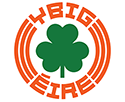The connection between football and dog racing highlights the history and evolution of sporting events. In the past, football stadiums usually served multiple purposes, including hosting greyhound dog racing alongside football matches. This was mainly due to a lack of dedicated venues and the opportunity to generate additional income.
However, as the popularity of dog racing declined over time, the need for dual-purpose stadiums diminished. Today, stadiums are primarily focused on football, and dog racing-specific grounds have been constructed separately.
Greyhound racing has a rich history in Ireland. The sport gained popularity in the early 20th century and quickly became ingrained in Irish culture.
As the popularity of greyhound racing grew, there were demands for a premier event that showcased the best Irish greyhound athleticism. The Irish Greyhound Derby was established for that purpose.
Fast forward to today, the Irish Greyhound Derby remains one of the most prestigious events in greyhound racing. This event has evolved over the years, adapting to the changing landscape of the sport. It has grown into a national event from its humble beginnings as a local race.
The derby has had various modifications in its format and rules. Held annually in Ireland, it features the fastest and most skilled greyhounds nationwide, competing for the coveted title.
Massive cultural impact
The derby holds significant financial importance for the greyhound racing industry in Ireland. It attracts a large audience, both in-person and online.
This event generates large revenue through ticket sales, sponsorship deals, and media rights. The Irish Greyhound Derby also contributes to the local economy by attracting tourists and visitors.
Besides the economic impact, the derby holds cultural significance in Ireland. It has become ingrained in the national sporting culture. It promotes Irish culture, tradition and heritage.
Various social and community events often accompany the derby. Its association with sports betting further enhances its impact. In every race, casual and avid bettors try to find the best odds on the dogs running.
Racing for glory
The derby typically consists of many rounds, starting with heats. The top performers from each heat then advance to the later rounds — quarter-finals, semi-finals, and the grand final.
The competition is incredibly fierce. Trainers and jockeys use various strategies to gain a competitive edge. Factors such as weather, track surface, and the position of the mechanical lure can influence race dynamics.
Training focuses on enhancing their greyhounds’ fitness, speed, and endurance through specialized conditioning programs. Trainers even study their competitors’ past performances to devise effective strategies.
Greyhounds to compete
Greyhounds possess remarkable speed, agility, and endurance. Their keen senses — particularly eyesight — allow them to race on the track with ease. Their intelligence also enables them to follow the game’s mechanism precisely. In short, this breed is ideal for racing competitions.
Successful racing greyhounds display a combination of physical attributes and mental aptitude. They have lean, muscular bodies built for sprinting, with solid hindquarters that provide strong acceleration.
Racing greyhounds must exhibit a competitive spirit, focus, and an innate instinct for chasing. These qualities will contribute to their success on the racetrack.
The breeding and bloodlines play a crucial role in their racing abilities. Breeders carefully select mating pairs based on lineage, performance records, and desired traits. This breeding system produces offspring with great potential on the track.





